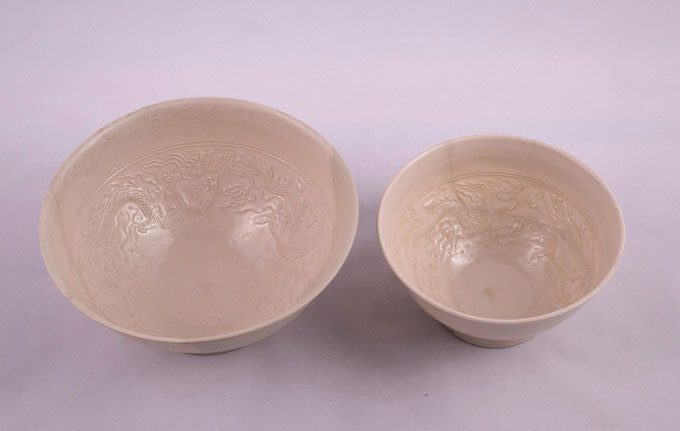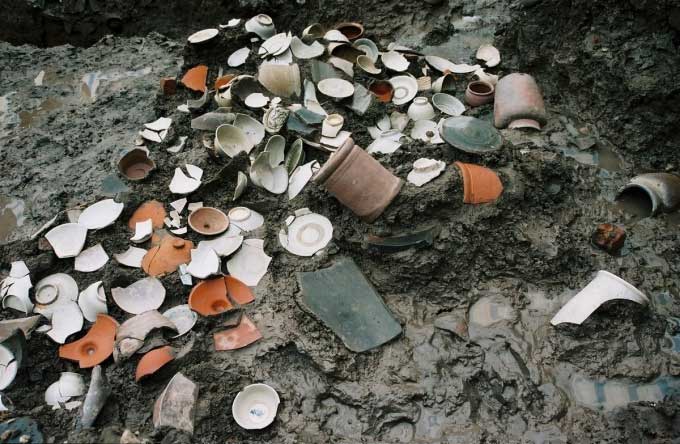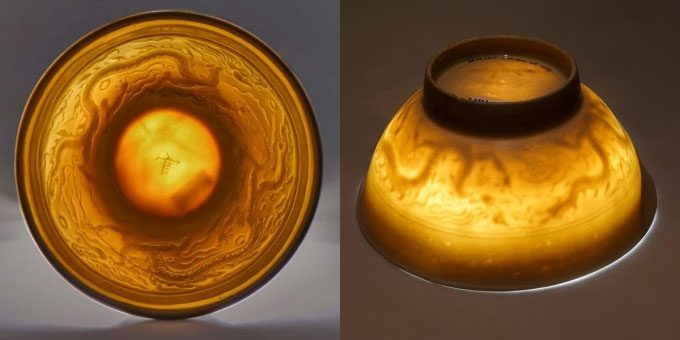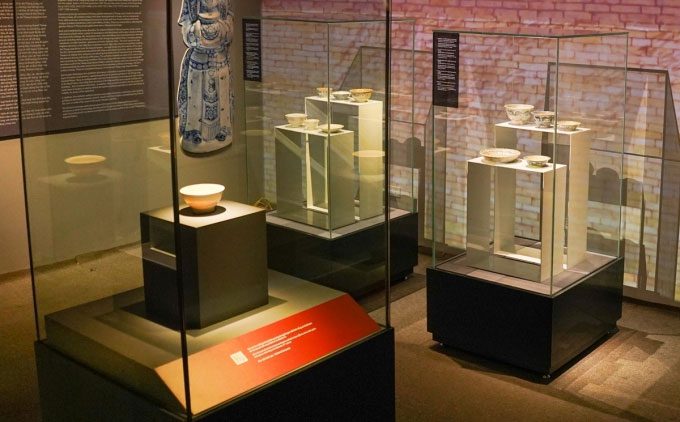Two White Porcelain Bowls with Dragon Motifs: Royal Artifacts from the Thang Long Palace
The two bowls are among 23 artifacts recognized as national treasures by Deputy Prime Minister Vu Duc Dam in December 2021. Currently, one of the bowls is on display at the Thang Long Palace Treasures exhibition within the Thang Long Imperial Citadel.
The larger bowl measures 6.5 cm in height, with a mouth diameter of 14.5 cm and a base diameter of 6.5 cm. The smaller bowl has the same height but a mouth diameter of 12.4 cm and a base diameter of 5.2 cm. Both bowls are spherical in shape, with evenly curved bodies, flared mouths, rounded edges slightly turned outward, and tall bases. The walls are thin, with an average thickness of 0.15-0.3 cm, made from opaque white porcelain, covered with a transparent glaze, and featuring embossed patterns in the bowl’s interior when glazed.

Two porcelain bowls of different sizes but similar structure and pattern. (Photo: Thang Long Imperial Citadel)
According to the cultural heritage documentation from the Cultural Heritage Department, the larger bowl was discovered in a dig layer at Area A of the 18 Hoang Dieu Archaeological Site, Ba Dinh, along with many other ceramic and glazed artifacts from the Early Le period. The bowl was broken and missing some pieces, with fragments located in a position indicating it had been subjected to pressure from the layers of soil above. After excavation, the fragments were reassembled, and the missing parts were restored using a mixture of powdered stone and two-component glue.
The smaller bowl was found at a depth of 1.7-1.8 meters from the ground, approximately 100 meters away from the larger bowl. It was located alongside many high-quality glazed ceramic artifacts from the Early Le period, earthenware, and architectural materials, all covered above by traces of a wooden boat. At that time, the bowl had cracks around its body but was not completely detached. The cracked areas were later reinforced with glue.

Excavation site of the bowls. (Photo: Cultural Heritage Department)
Despite their size differences, the structure, themes, and decorative techniques of the two bowls are identical. The designs are embossed within the bowls. Approximately 1.8 cm from the rim are two raised lines, below which are images of two dragons soaring through the clouds, forming a circular pattern on the bowl’s body. The dragons have their heads held high, mouths emitting jewels, bodies coiled in multiple segments, tails extended backward, and legs appearing to tread upon the clouds. The dragons feature manes and prominent foreheads, with five-clawed feet, characteristic of the dragon imagery reserved for emperors. In the center of the bowl, the word “Quan” is embossed.

Dragon patterns are clearly visible when the bowl is illuminated. (Photo: Thang Long Imperial Citadel)
The two bowls are recognized as national treasures due to their originality, uniqueness, and exceptional cultural value, linked to the Thang Long Imperial Citadel.
The bowls date back to the Early Le period, specifically the 15th and 16th centuries. The word “Quan” embossed in the bowl indicates that these were produced by the royal kiln—an establishment created by the court to manufacture items for the king and the royal family. This was also where the finest artisans from various craft villages throughout the country were concentrated.
As royal utensils, the bowls are referred to as “ngự dụng” (royal use items). Additionally, “ngự dụng” can also refer to items used by the queen. The bowls were excavated alongside many high-quality utensils, including some bowls and plates marked with “Trường Lạc.”
According to the Complete History of Đại Việt, Trường Lạc was the name of a palace within the Thang Long Imperial Palace during the Early Le period. King Hiến Tông honored his mother, Queen Nguyễn Thị Hằng, as Empress Dowager and used the name of this palace as her honorary title, calling her Trường Lạc Hoàng Thái Hậu. Later, she was further honored as Trường Lạc Thái Hoàng Thái Hậu. Therefore, the Trường Lạc palace is often associated with Queen Nguyễn Thị Hằng.
Associate Professor Bùi Minh Trí noted that the two artifacts meet all criteria: the porcelain is made from kaolin with a glaze, fired at temperatures above 1,200 degrees Celsius, fully vitrified throughout its thickness, producing a sound like a bell when struck, and is semi-translucent (light can pass through half the thickness of the porcelain).
The porcelain body—the core of the ceramic product—lies beneath the glaze or decoration and is made from high-purity kaolin. When fired at high temperatures, this process creates thin, translucent porcelain while ensuring durability. The materials used for the white glaze are also carefully refined to achieve a thin, transparent layer. The products were fired individually at standard temperatures and techniques.
The two artifacts were crafted using the “impression technique,” also known as the “stamp technique,” which involves using molds to create patterns on the ceramic body before glazing. To print fine details and patterns, this must be done while the body is still wet, requiring near-perfect precision.
According to documentation from the National History Museum, this type of white porcelain bowl decorated with dragons and featuring a thin body has only been found at the Lam Kinh site (Thanh Hoa) and the Thang Long Imperial Citadel, but in limited quantities. At the tombs and ancestral temples of the Later Le dynasty in Lam Kinh, archaeologists discovered several fragments of white porcelain bowls with embossed five-clawed dragons, but they could not be fully restored. At the Thang Long Imperial Citadel, many specimens have been found, but few retain their original shapes.
Associate Professor Bùi Minh Trí, Director of the Institute for Imperial City Research, mentioned that during their visits to Vietnam, Japanese Prime Minister Junichiro Koizumi (in 2002) and French President Jacques Chirac (in 2004) both visited the Thang Long Imperial Citadel and admired the porcelain bowls. “Both praised the bowls for their exquisite beauty, perfection, quality, and noble origins,” Mr. Trí stated.

One porcelain bowl (left) displayed at the “Thang Long Palace Treasures” exhibition. (Photo: Phạm Chiểu)
The treasure documentation states: “Not only are these unique artifacts, but they are also the most complete examples in the collection of high-quality white porcelain bowls decorated with dragons and royal utensils from the Early Le period currently known.”





















































